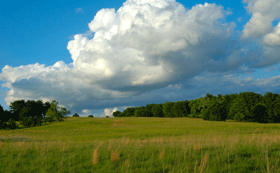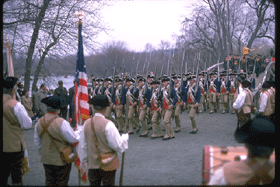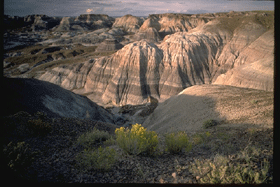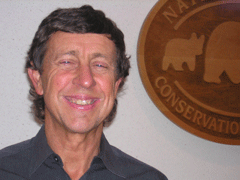Heritage for Sale
Air Date: Week of April 11, 2008

Valley Forge National Park. Developers want to build a hotel, museum, and conference center on private land inside the park. (Courtesy of NPCA)
Privately held land is for sale inside 56 national parks. Ron Tipton from National Parks Conservation Association tells host Bruce Gellerman why the federal government has found willing sellers but can't afford to buy the private holdings in places like Zion National Park.
Transcript
[HOOFBEATS]
GELLERMAN: Listen my children and you shall hear…a reenactment of the midnight ride of Paul Revere.
[MAN SHOUTS: THE REGULARS ARE OUT; HOOFBEATS; MAN SAYS, “HALT, SIR, WHO ARE YOU AND WHAT IS YOUR BUSINESS?” MAN REPLIES, “REVERE, MY NAME’S REVERE, AND I COME WITH URGENT NEWS…]
GELLERMAN: Patriot Paul Revere’s hurry of hoofs in a village street is revered to this day, and a scene reenacted each year. But who remembers why the British troops were marching from Boston to Concord, Massachusetts, in the first place? Turns out, Red Coat spies had learned that there were massive amount of munitions hidden on James Barrett’s Farm in Concord. The shot heard round the world that marked the beginning of the American Revolution actually took place a mile and a half away, at North Bridge, on land now protected by the federal government as the Minute Man National Historical Park.
But Barrett’s farm, which played such a pivotal part of in the nation’s history, isn’t part of the National Park – at least not yet. It’s one of 55 sites the National Parks Conservation Association hopes to integrate into the federal system.
Ron Tipton is senior vice president of the organization, which just released a report, “America’s Heritage for Sale.” And Mr. Tipton, why isn’t Barrett’s farm part of the Minute Man National Park?

Actors reenact the Revolutionary War at Minute Man National Park in Massachusetts. The federal government owns the site where the revolution began but not Barrett’s Farm, where the revolutionaries stored their weapons. (Courtesy of the National Park System)
GELLERMAN: Now, many of the places that you cite in your report are actually within National Parks – these are private lands that are in these parks.
TIPTON: Exactly. In fact, most of the areas in our report, which covers 55 National Park units, are already within the boundaries for those parks that were established by Congress. And I don’t think that the public realizes that we’re falling behind in our ability to, uh, protect those lands.
GELLERMAN: Well, protect them from what? What’s the problem?
TIPTON: Well, there are many problems. If these lands aren’t owned by the Park Service, they are always subject to being developed. Right now, there is a huge battle going on – you could call it the second battle of Valley Forge – there is a landowner there who wants to develop a major museum, but also a large hotel and conference center, right in the middle of Valley Forge. And we’re in a big fight with the developer and with local zoning authorities to get that land purchased by the National Park Service.

The National Park System wants to add 28,000 acres to the Petrified Forest National Park but doesn’t have the funds to buy the surrounding land from a former rancher who wants to sell.
Credit: (National Park System)
TIPTON: Those kinds of facilities are available all around Valley Forge. We’re talking about suburban Philadelphia, 20-minute drive from downtown. The problem is, with a hotel and a conference center, is that that would be major development in what we would call ‘hallowed ground.’ This was part of the Continental Army’s encampment during the famous retreat to Valley Forge.
GELLERMAN: I want to ask you about Zion National Park, which I think is one of the most beautiful places in the country. There’s actually development going on there right now.
TIPTON: Yes. In fact, two years ago a very important piece of land in the middle of Zion National Park was purchased by a couple from California, and they defied the Park Service, who had a willingness to buy but no money, and built what is being called a mini-retreat but is actually a very large mansion on this property within the heart of the park.
GELLERMAN: One of the places that you want to buy up is in the Petrified Forest in Arizona. And that’s the largest one at what, 125,000 acres.

Ron Tipton, senior vice president of NPCA, says unless the federal government acts to protect America’s national parks, the country’s favorite places could face more commercial development.(Courtesy of NPCA)
Not a single acre of that land has been purchased in the last four years. The landowner of 28,000 acres, a big ranch, is willing to sell – in fact he’s not a willing seller, he’s a desperate seller. We’re estimating six million dollars is our current estimate to buy those 28,000 acres – but eventually that landowner is going to be forced to sell.
GELLERMAN: Well, he wants to sell – the Park Service wants to buy it.
TIPTON: Right.
GELLERMAN: What’s the problem?
TIPTON: Well, the problem is money. Basically, the Park Service needs about 100 to 150 million dollars a year, and the last several years it’s been getting 30 or 40 million dollars. A number of states – not just the big states like California and New York, but even smaller states like Maryland, where I live – usually spend more money each year on conservation of lands in their state than the National Park Service has available for the entire National Park system.
GELLERMAN: So, this is a question of allocating the resources.
TIPTON: Exactly. And you have a funding source, the Land and Water Conservation Fund that was established for this purpose. 900 million dollars a year is supposed to go to conservation and recreation lands from the Land and Water Fund.
That money comes from the royalties that are paid for offshore oil and gas leasing in the United States outer continental shelf and in the Gulf of Mexico. And, you know, the deal that was made 40 years ago was, we’re going to protect federal resources with some of those revenues – and the federal government is not fulfilling its end of the bargain.

Valley Forge National Park. Developers want to build a hotel, museum, and conference center on private land in Valley Forge.
(Courtesy of NPCA)
TIPTON: Those requests are from the Bush administration, and they have not championed this program, to say the least. America’s heritage is for sale, unfortunately, and private interests have the opportunity to buy it. It is for sale to the public through the National Park Service who should be the ones who purchase it. I mean, this is an amazing range of places of natural beauty, ecological importance, wildlife habitat, and history, culture and diversity that our National Park system represents.
GELLERMAN: Well, Mr. Tipton, I want to thank you very much.
TIPTON: Thank you, Bruce. My pleasure.
GELLERMAN: Ron Tipton is senior vice president of National Parks Conservation Association.
Links
Living on Earth wants to hear from you!
Living on Earth
62 Calef Highway, Suite 212
Lee, NH 03861
Telephone: 617-287-4121
E-mail: comments@loe.org
Newsletter [Click here]
Donate to Living on Earth!
Living on Earth is an independent media program and relies entirely on contributions from listeners and institutions supporting public service. Please donate now to preserve an independent environmental voice.
NewsletterLiving on Earth offers a weekly delivery of the show's rundown to your mailbox. Sign up for our newsletter today!
 Sailors For The Sea: Be the change you want to sea.
Sailors For The Sea: Be the change you want to sea.
 The Grantham Foundation for the Protection of the Environment: Committed to protecting and improving the health of the global environment.
The Grantham Foundation for the Protection of the Environment: Committed to protecting and improving the health of the global environment.
 Contribute to Living on Earth and receive, as our gift to you, an archival print of one of Mark Seth Lender's extraordinary wildlife photographs. Follow the link to see Mark's current collection of photographs.
Contribute to Living on Earth and receive, as our gift to you, an archival print of one of Mark Seth Lender's extraordinary wildlife photographs. Follow the link to see Mark's current collection of photographs.
 Buy a signed copy of Mark Seth Lender's book Smeagull the Seagull & support Living on Earth
Buy a signed copy of Mark Seth Lender's book Smeagull the Seagull & support Living on Earth

